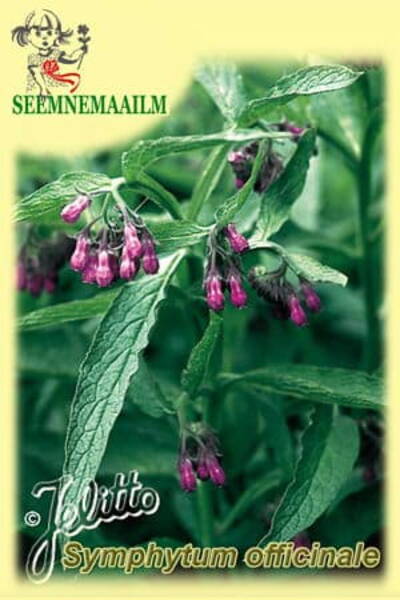Ex Tax: 2.75€
Environmentally friendly seeds for organic farming.
Medicinal perennial from the Boraginaceae family.
Flowering plant height: 80 cm.
Flower colour: purple or cream.
Natural flowering period: May - July.
Excellent honey plant.
Winter hardiness zones: Z4 - Z8.
Location: comfrey can grow in both light and light partial shade. Comfrey roots can easily penetrate any corner of the garden. If it is excessively annoying, cut the plant at the root, and in those places where you would not like to see it again, sprinkle the cut area with salt.
Soil: comfrey grows well in any soil, but does not like soil that is too acidic or heavy. Therefore, the soil must be deeply cultivated.
Reproduction: seeds do not need stratification. 1.0 g = 110 seeds.
When sowing in spring, seedlings appear after 2-3 weeks, but, as a rule, they are quite rare. Pre-winter crops produce denser seedlings. In the first year, a rosette of leaves is formed; starting from the second year, the plants bloom and bear fruit. Comfrey grows late in the spring, usually in May. Blooms in June, seeds ripen in August. Collecting a large number of seeds is very difficult, because they do not ripen at the same time, and when ripe, they immediately fall off.
Comfrey reproduces very easily vegetatively, by cuttings of rhizomes and roots; comfrey roots are capable of producing root suckers. New plants can be grown even from a small section of the root collar. For propagation, it is better to take plants 3-4 years old.
In England, this method of propagating comfrey is practiced: pieces of roots are placed in a damp bag, which is placed in a warm, dark and damp place. Soon shoots appear, when they reach 1.5-2.0 cm in length, they are planted in the ground.
Use: very promising in group plantings, near fences and outbuildings.
And also: liquid fertilizer from comfrey. Comfrey leaves and stems contain large amounts of plant protein. From them you can prepare an excellent liquid fertilizer, which, along with nitrogen, contains many other minerals, as well as microelements. To do this, place two full handfuls of dried comfrey greens in a plastic or earthenware container and fill with 10 liters of heated water. The mixture is kept for three to four days to ferment. Then it is diluted with water in a ratio of 1: 3 or 1: 5 (depending on the need for feeding), and garden plants are watered with this solution every two weeks. The resulting fertilizer cannot be used without dilution: because in this form it is very caustic and plants will not absorb it.
You can feed indoor and balcony plants with comfrey fertilizer, diluting it 5 times (more is possible). In addition to the fermented solution, you can also use fermented solution.
It is prepared like this: take 1 kg of fresh or 200 g of dry leaves and stems of comfrey and fill them with 10 liters of water, preferably rainwater. After three or four days it all turns into a sticky mess, and after a week the fertilizer is ready. For dry soil it is diluted in a ratio of 1:20, for wet soil - 1:10. Liquid fertilizers are applied to wet soil only on cloudy days.
Fermented comfrey fertilizer is beneficial to all plants, but it has a particularly beneficial effect on celery, cabbage and tomatoes. Tomatoes can be fed daily, adding 0.5 liters per plant at the root. All soil inhabitants love feeding with comfrey, so it is useful to add it little by little to the compost. If you do not want to waste time and energy preparing fertilizer, then cut off the large leaves of the comfrey before flowering and mulch the ground with them.












